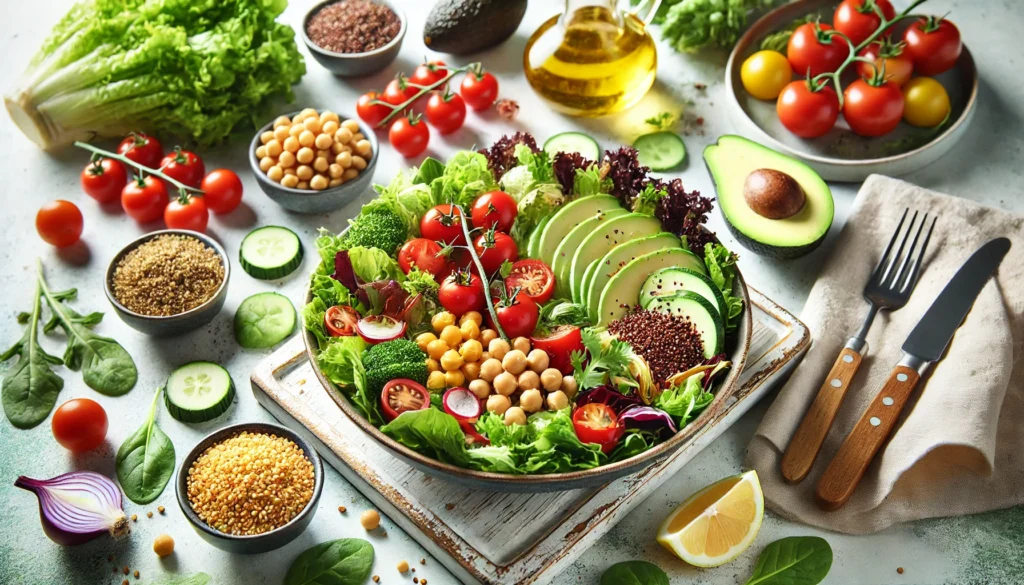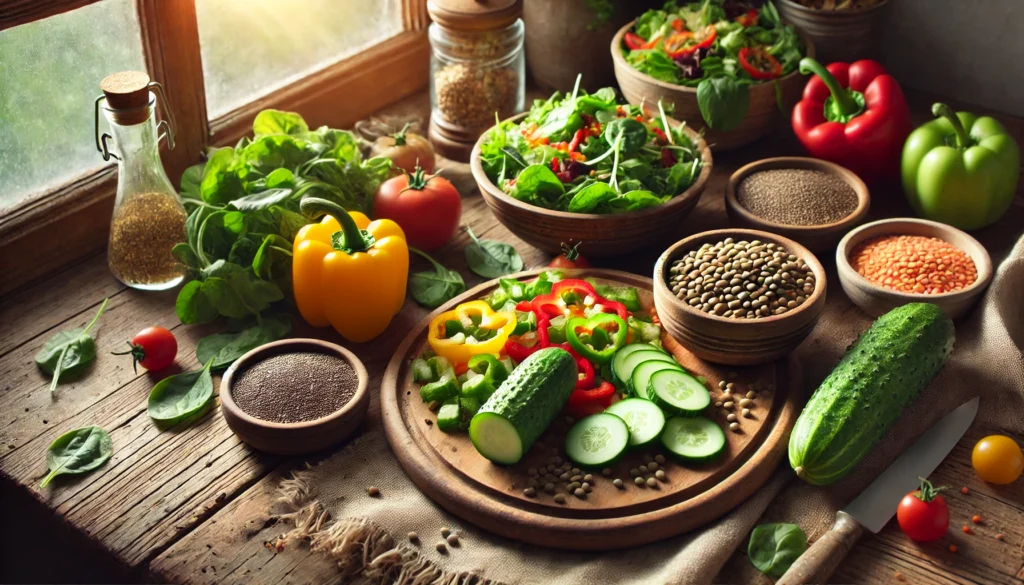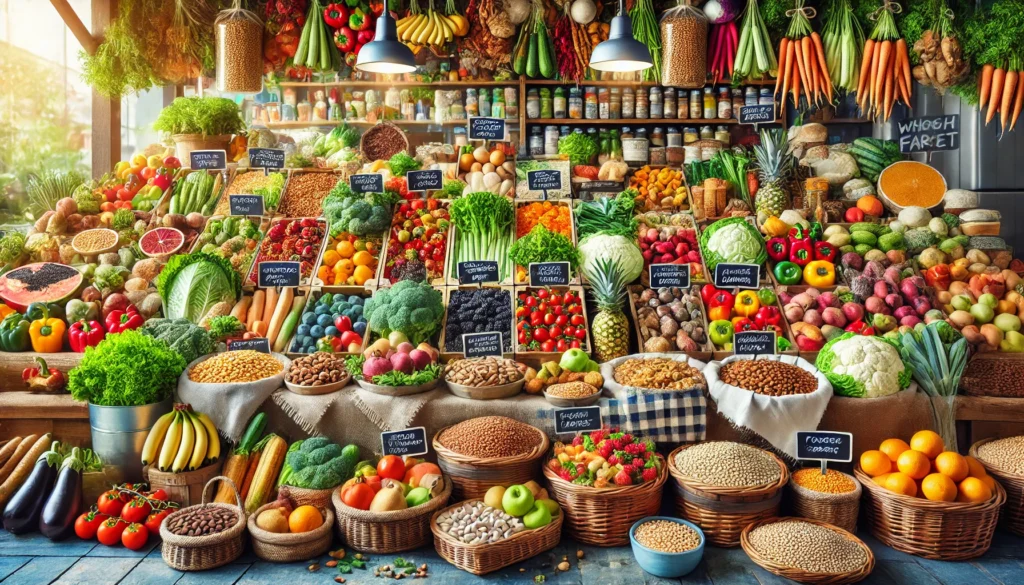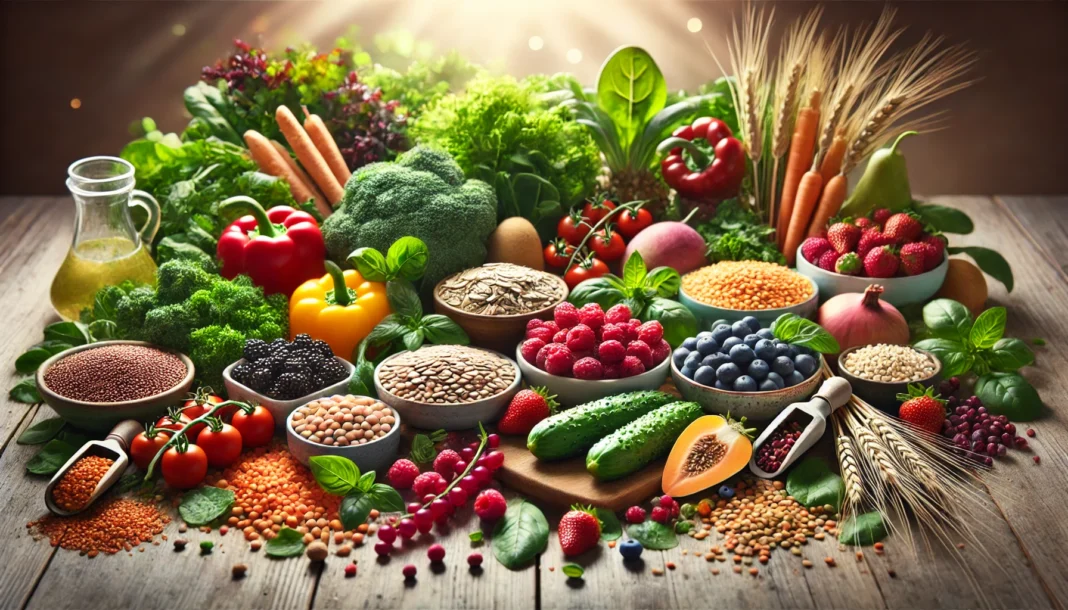Understanding the Role of Fiber in Weight Loss
A plant-based diet rich in high fiber, low calorie foods provides significant benefits for weight management. Fiber plays a crucial role in satiety, digestion, and metabolic health. When consumed in adequate amounts, fiber aids in slowing digestion, stabilizing blood sugar levels, and promoting a sustained feeling of fullness, which can reduce overall calorie intake. The physiological mechanisms behind fiber’s effectiveness in weight loss are supported by extensive scientific research, emphasizing its ability to improve gut health and regulate energy metabolism.
You may also like: How to Start a Whole Food Plant-Based Diet: A Beginner’s Guide to Healthier Eating
Fiber exists in two main forms: soluble and insoluble. Soluble fiber dissolves in water, forming a gel-like substance that helps regulate cholesterol levels and blood sugar. Insoluble fiber, on the other hand, does not dissolve in water and facilitates the smooth passage of food through the digestive system, preventing constipation and promoting bowel regularity. Both forms contribute to improved digestion and metabolic efficiency, making them essential components of a weight-loss-focused plant-based diet.

How a Plant-Based Diet Supports Fiber Intake
Adopting a plant-based diet inherently increases fiber intake since plant-derived foods are the primary sources of dietary fiber. Unlike processed foods, which are often stripped of their natural fiber content, whole, unprocessed plant foods retain their nutritional integrity, offering a combination of vitamins, minerals, and fiber that contribute to overall health and weight management.
Plant-based diets also tend to be lower in calorie density, meaning they provide fewer calories per gram of food. This makes it easier to consume larger portions without exceeding daily caloric needs. High fiber, low calorie foods allow for greater volume consumption while maintaining a calorie deficit, a fundamental principle of weight loss.
Best High-Fiber, Low-Calorie Foods for Weight Loss
Leafy Greens: The Ultimate Weight Loss Powerhouses
Leafy greens such as spinach, kale, Swiss chard, and arugula are among the best fiber foods for weight loss due to their exceptional nutrient density and low-calorie content. These greens are rich in both soluble and insoluble fiber, making them effective in enhancing digestion and promoting satiety.
Spinach, for instance, contains a significant amount of fiber while being extremely low in calories. A single cup of raw spinach provides approximately 0.7 grams of fiber with only seven calories. Kale, another nutritional powerhouse, offers a slightly higher fiber content, with one cup providing around 1.3 grams of fiber and just 33 calories. The high water content in these greens further enhances their ability to keep you full, making them ideal for those seeking sustainable weight loss.
Cruciferous Vegetables: Fiber-Rich and Nutrient-Dense
Cruciferous vegetables, including broccoli, cauliflower, Brussels sprouts, and cabbage, are excellent sources of plant based diet fiber. These vegetables contain high amounts of fiber, vitamins, and antioxidants that support metabolic health and inflammation reduction.
Broccoli, for instance, provides 2.4 grams of fiber per cup while containing only 55 calories, making it an excellent choice for those aiming to increase fiber intake without consuming excess calories. Brussels sprouts, another fiber-rich cruciferous vegetable, offer nearly 4 grams of fiber per cup, supporting optimal digestion and promoting gut health. Their slightly bitter taste can be balanced with healthy preparation methods such as roasting or steaming with lemon juice to enhance palatability while retaining their nutritional benefits.
Legumes and Beans: A Plant-Based Protein and Fiber Powerhouse
Legumes, including lentils, black beans, chickpeas, and kidney beans, are among the best high fiber, low calorie foods for weight loss. They provide a unique combination of protein and fiber, which work synergistically to promote satiety and support muscle maintenance during weight loss.
Lentils, for example, are exceptionally fiber-rich, offering around 15.6 grams of fiber per cup while containing approximately 230 calories. Black beans, another fiber-dense option, provide about 15 grams of fiber per cup and 227 calories. These foods not only contribute to fullness but also improve gut microbiome diversity, which has been linked to better weight management and metabolic health.
Whole Grains: Fiber-Rich Carbohydrates for Sustained Energy
Whole grains such as quinoa, oats, brown rice, and barley are valuable components of a plant-based diet for weight loss. Unlike refined grains, which have been stripped of their fiber content, whole grains retain their nutrient-dense bran and germ layers, providing sustained energy and digestive benefits.
Quinoa, for instance, offers 5.2 grams of fiber per cup while supplying a moderate 222 calories. As a complete protein source containing all nine essential amino acids, quinoa supports muscle preservation and enhances satiety. Similarly, oats are an excellent source of soluble fiber, particularly beta-glucan, which has been shown to reduce hunger and improve cholesterol levels. One cup of cooked oats provides 4 grams of fiber and 154 calories, making it a filling and nutritious breakfast option for those on a weight-loss journey.
Berries: Nutrient-Dense Fruits for Weight Loss
Berries, including raspberries, blackberries, blueberries, and strawberries, are among the most fiber-dense fruits available. Their natural sweetness satisfies cravings for sugary foods while delivering essential vitamins, antioxidants, and fiber to support digestion and metabolic health.
Raspberries, for instance, contain an impressive 8 grams of fiber per cup while only providing 64 calories, making them one of the best fiber foods for weight loss. Blackberries follow closely, with 7.6 grams of fiber per cup and 62 calories. These fruits can be incorporated into smoothies, oatmeal, or enjoyed as a standalone snack to enhance fiber intake without excess caloric consumption.
Strategies for Maximizing Fiber Intake on a Plant-Based Diet
Incorporating high fiber, low calorie foods into daily meals requires strategic planning to ensure optimal fiber intake without excessive calorie consumption. One effective approach is to prioritize whole, unprocessed foods while minimizing reliance on refined grains and processed plant-based alternatives.
Another key strategy is to distribute fiber intake evenly throughout the day. Instead of consuming a large amount of fiber in a single meal, spreading fiber-rich foods across multiple meals can prevent digestive discomfort while maintaining consistent satiety levels. Additionally, staying hydrated is crucial when increasing fiber intake, as fiber absorbs water and requires adequate hydration for optimal digestion.

Frequently Asked Questions: High-Fiber, Low-Calorie Foods for Weight Loss on a Plant-Based Diet
1. How does fiber contribute to weight loss beyond just digestion?
Fiber does much more than just support digestion; it actively regulates appetite, hormonal balance, and fat metabolism. When consumed regularly, high fiber, low calorie foods help modulate hunger hormones such as ghrelin and leptin, preventing overeating and unnecessary snacking. Additionally, fiber slows the absorption of sugars, which prevents insulin spikes that can lead to fat storage. Another overlooked benefit of fiber is its role in promoting the release of gut hormones that signal fullness to the brain, reinforcing long-term satiety. This means that integrating plant based diet fiber into meals not only supports digestion but also aligns with the body’s natural mechanisms for maintaining a healthy weight.
2. Are there specific high-fiber foods that target belly fat?
While no single food directly “burns” belly fat, certain high fiber, low calorie foods can help reduce overall fat accumulation, particularly in the abdominal area. Soluble fiber, found in foods like oats, flaxseeds, and legumes, forms a gel-like consistency in the stomach, slowing digestion and improving fat metabolism. Additionally, these foods promote the growth of beneficial gut bacteria, which are linked to reduced visceral fat. Studies show that individuals who consume high amounts of plant based diet fiber tend to have lower body fat percentages, especially around the midsection. By regularly incorporating fiber-rich foods into meals, the body becomes more efficient at processing fat rather than storing it.
3. How can I increase my fiber intake without causing digestive discomfort?
A sudden increase in fiber can sometimes lead to bloating and gas, but there are ways to prevent this while still benefiting from high fiber, low calories foods. The key is to increase fiber intake gradually, allowing the digestive system to adjust over time. Drinking plenty of water is also essential, as fiber absorbs liquid to form bulk in the intestines. Additionally, opting for cooked vegetables instead of raw ones can make digestion easier while still providing essential fiber. Fermented foods, such as kimchi or sauerkraut, can also help balance gut bacteria and improve the digestion of plant based diet fiber. Over time, the body adapts, making it easier to handle higher fiber consumption with fewer side effects.
4. Can high-fiber foods help regulate blood sugar levels?
Yes, one of the biggest benefits of high fiber, low calorie foods is their ability to stabilize blood sugar levels, making them particularly beneficial for individuals with insulin resistance or diabetes. Soluble fiber slows the absorption of carbohydrates, preventing rapid spikes and crashes in blood glucose levels. Foods like beans, lentils, and whole grains not only provide fiber but also contain complex carbohydrates that provide steady energy release. Additionally, fiber improves insulin sensitivity over time, making it easier for the body to regulate sugar levels naturally. This means that incorporating the best fiber foods for weight loss also supports long-term metabolic health and energy stability.
5. How does fiber impact gut health and weight loss simultaneously?
The gut microbiome plays a crucial role in both digestion and weight management, and high fiber, low calories foods directly influence the composition of gut bacteria. Fiber acts as a prebiotic, feeding the beneficial bacteria that help break down food efficiently and produce short-chain fatty acids, which have been linked to fat metabolism. A well-balanced gut microbiome improves nutrient absorption, enhances satiety signals, and reduces inflammation, all of which contribute to weight management. Moreover, individuals with diverse gut bacteria are more likely to maintain a healthy weight compared to those with an imbalanced microbiome. By consistently consuming plant based diet fiber, gut health and weight loss become interconnected benefits.
6. Are all sources of fiber equally effective for weight loss?
Not all fiber sources have the same impact on weight loss. While both soluble and insoluble fiber are essential, soluble fiber—found in foods like chia seeds, oats, and legumes—tends to be more effective in promoting satiety and reducing calorie absorption. Insoluble fiber, present in foods like whole grains and vegetables, aids digestion but does not slow digestion as effectively. Fermentable fibers, such as those in bananas and onions, provide additional gut health benefits, which indirectly support weight management. For the best results, a combination of different fiber types should be included in a diet focused on high fiber, low calorie foods. This ensures a well-rounded approach to weight loss and digestive health.
7. What are some creative ways to incorporate more fiber into daily meals?
Increasing fiber intake doesn’t have to mean eating the same foods repeatedly. Simple swaps, such as using whole grain flour instead of refined flour in baking or adding flaxseeds to smoothies, can significantly boost fiber intake. Another creative approach is using pureed beans in soups and sauces to increase fiber without altering taste. Roasting chickpeas for a crunchy snack or using cauliflower rice as a low calorie fiber alternative to traditional grains are also excellent options. By diversifying the ways plant based diet fiber is consumed, meals remain exciting while still being nutritionally beneficial.
8. Can a high-fiber diet improve workout performance and recovery?
While fiber itself does not directly enhance athletic performance, its role in stabilizing energy levels and improving digestion can indirectly support exercise. Consuming high fiber, low calorie foods ensures a steady release of energy, preventing crashes that could impact endurance. Additionally, fiber-rich foods help maintain a healthy gut, which plays a role in nutrient absorption, including proteins and essential minerals that aid muscle recovery. A well-balanced diet containing the best fiber foods for weight loss can also reduce inflammation, which is crucial for recovery after intense workouts. Athletes who incorporate adequate fiber while balancing macronutrients tend to experience better overall performance and reduced fatigue.
9. How can fiber intake influence cravings and emotional eating?
One of the lesser-known benefits of high fiber, low calories foods is their impact on emotional eating and cravings. Fiber slows digestion, keeping blood sugar levels stable and preventing sudden hunger pangs that often lead to unhealthy snacking. Additionally, fiber-rich meals tend to be more filling, reducing the likelihood of reaching for calorie-dense comfort foods. Certain fibers, like those found in oats and beans, also promote the production of serotonin, the neurotransmitter responsible for mood regulation. By strategically incorporating plant based diet fiber into meals, individuals can develop healthier eating patterns and reduce reliance on processed foods for emotional satisfaction.
10. What are the long-term health benefits of maintaining a high-fiber diet?
Beyond weight loss, a diet rich in high fiber, low calorie foods provides numerous long-term health benefits. Regular fiber consumption has been linked to a reduced risk of heart disease, lower cholesterol levels, and improved digestive function. Fiber also plays a role in maintaining cognitive health by reducing inflammation and supporting brain-gut communication. Additionally, high fiber intake has been associated with lower risks of certain cancers, particularly those related to the digestive tract. Incorporating the best fiber foods for weight loss into a daily diet not only supports immediate weight management goals but also contributes to a longer, healthier life.

Conclusion: Embracing a High-Fiber, Low-Calorie Plant-Based Diet for Sustainable Weight Loss
A plant-based diet rich in fiber offers numerous benefits for weight loss, digestive health, and overall well-being. By incorporating the best high fiber, low calorie foods, individuals can enhance satiety, regulate appetite, and maintain energy balance without unnecessary calorie consumption. Leafy greens, cruciferous vegetables, legumes, whole grains, and berries serve as foundational elements of a fiber-rich diet, supporting long-term weight management and metabolic health.
With careful planning and mindful eating habits, a high-fiber, low-calorie plant-based diet can be both satisfying and effective in achieving sustainable weight loss. Prioritizing whole foods and making informed dietary choices empower individuals to optimize their health while enjoying the diverse and delicious options available within a plant-based lifestyle.
Further Reading:
22 High Fiber Foods You Should Eat
How to Lose Weight on a Vegetarian Diet
50 low calorie foods to incorporate into your diet
plant-based nutrition, fiber-rich diet, weight loss foods, healthy eating, gut health, whole food diet, natural weight loss, best plant foods, fiber for digestion, vegan diet tips, calorie deficit foods, nutrient-dense meals, metabolism-boosting foods, fiber benefits, plant protein sources, low-calorie meal ideas, superfoods for weight loss, healthy lifestyle tips, sustainable dieting, high-fiber vegetables
The information contained in this article is provided for general informational purposes only and is not intended to serve as medical, legal, or professional advice. While NewsHealthWatch strives to present accurate, up-to-date, and reliable content, no warranty or guarantee, expressed or implied, is made regarding the completeness, accuracy, or adequacy of the information provided. Readers are strongly advised to seek the guidance of a qualified healthcare provider or other relevant professionals before acting on any information contained in this article. NewsHealthWatch, its authors, editors, and contributors expressly disclaim any liability for any damages, losses, or consequences arising directly or indirectly from the use, interpretation, or reliance on any information presented herein. The views and opinions expressed in this article are those of the author(s) and do not necessarily reflect the official policies or positions of NewsHealthWatch.

